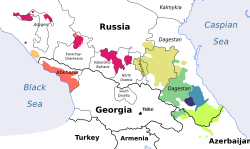| Kubachi | |
|---|---|
| Kubachin | |
| гӀюгъбугъан куб/гъай [1] | |
| Pronunciation | [ʡūˁʁbugankub/ʁaj] |
| Native to | North Caucasus |
| Region | Dagestan |
Native speakers | 7,000 (2020) [2] |
| Cyrillic script | |
| Language codes | |
| ISO 639-3 | ugh |
| Glottolog | kuba1248 |
 Kubachi | |
Kubachi (alternatively Kubachin) is a language in the Dargin dialect continuum spoken in Dagestan, Russia, by Kubachi people. [3] It is often considered a divergent dialect of Dargwa, but it has also historically been portrayed as a separate language. Ethnologue lists it as a separate language. [2]


